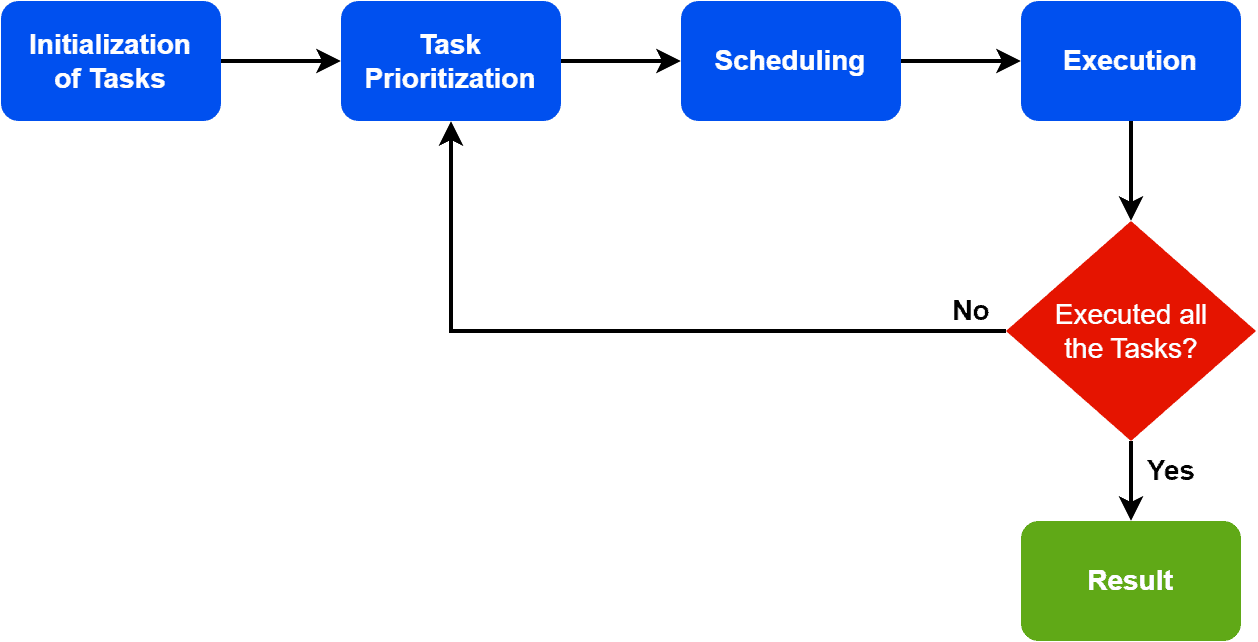1. 概述
在本篇文章中,我们将深入讲解一种动态优先级调度算法 —— 最早截止时间优先(Earliest Deadline First,简称 EDF)。我们将通过一个具体的示例来说明该算法的调度流程,并分析其优缺点。
2. 简介
最早截止时间优先(EDF)属于动态调度算法的一种,常用于实时操作系统中,用于调度具有明确截止时间的任务或进程。它是一种基于优先级的调度策略,其中截止时间越早的任务优先级越高。
EDF 的核心思想是:尽可能降低任务错过截止时间的概率。因此,每当有任务可调度时,系统会优先执行当前截止时间最早的任务。如果多个任务截止时间相同,则优先执行优先级更高的任务。
✅ 关键特性:
- 适用于周期性任务调度
- 能在任务总利用率不超过 100% 的前提下,确保所有任务按时完成
- 是一种最优调度算法
EDF 被广泛应用于分布式系统、网络、嵌入式系统、多媒体系统和实时控制系统等场景。
3. 调度流程
EDF 的调度过程主要包括以下几个步骤:
- 初始化任务:加载所有待调度任务,并为每个任务设定截止时间。
- 任务优先级排序:根据截止时间对任务进行排序,截止时间越早优先级越高。
- 任务调度选择:从当前可执行任务中选出优先级最高的任务。
- 任务执行:执行所选任务直到完成或截止时间到达。
如果任务在截止时间前完成,系统将重新进行任务排序并选择下一个任务执行。如果任务在截止时间后仍未完成,则标记为任务超时。
下面是一个 EDF 调度流程图:

⚠️ EDF 是一种动态优先级算法,这意味着任务的优先级会随着时间推移而变化。系统会根据当前时间点动态调整任务的优先级,确保最紧急的任务优先执行。
4. 示例说明
我们以三个任务 P1、P2 和 P3 来演示 EDF 的调度过程:
| 进程 | 执行时间(Capacity) | 截止时间(Deadline) | 周期(Period) |
|---|---|---|---|
| P1 | 3 | 7 | 20 |
| P2 | 2 | 4 | 5 |
| P3 | 2 | 8 | 10 |
解释:
- P1 每 20 个时间单位执行一次,必须在 7 个时间单位内完成 3 个单位的任务。
- P2 和 P3 类似,分别在 4 和 8 个单位时间内完成任务。
接下来我们模拟调度过程:
- 初始时刻,所有任务都就绪,P2 截止时间最早(4),优先执行,分配 2 个时间单位。
- 此时 P1(截止时间 7)和 P3(截止时间 8)就绪,P1 更紧急,分配 3 个时间单位。
- 剩余 P3 执行 2 个时间单位。
- 时间到达 5 后,P2 新任务到达,截止时间是 9(原 4 + 周期 5),此时 P3 截止时间是 8,P2 为 9,所以先执行 P3。
- P3 完成后,执行 P2。
调度结果如下图所示:

✅ 结论: 所有任务都在各自截止时间前完成,调度成功。
5. 优势分析
EDF 之所以在实时系统中被广泛使用,主要有以下几点核心优势:
✅ 1. 可调度性保障
只要任务总利用率不超过 100%,就能保证所有任务按时完成。
✅ 2. 高资源利用率
相比固定优先级调度算法,EDF 能更高效地利用 CPU 资源,提升系统整体吞吐量。
✅ 3. 动态适应能力强
任务优先级动态变化,能适应任务周期或截止时间的变动,适用于复杂多变的实时环境。
6. 劣势分析
尽管 EDF 有很多优点,但在实际使用中也存在一些挑战和限制:
❌ 1. 优先级倒置(Priority Inversion)
低优先级任务可能因资源占用而阻塞高优先级任务,导致任务超时。
❌ 2. 系统过载(Overloading)
当任务总利用率超过 100% 时,无法保证所有任务按时完成,系统性能急剧下降。
❌ 3. 行为不可预测
如果任务截止时间设置不合理,调度行为可能出现不可预测的情况。
❌ 4. 实现复杂度高
在大规模实时系统中,EDF 的实现和分析较为复杂,尤其是涉及资源竞争和同步机制时。
7. 总结
本文详细介绍了最早截止时间优先(EDF)调度算法的工作原理、调度流程、示例分析及其优缺点。
✅ 适用场景:
- 实时系统中任务具有明确截止时间
- 任务周期和执行时间已知
- 对任务完成时间有严格要求
❌ 不适用场景:
- 任务截止时间设置不明确
- 系统负载接近或超过 100%
- 存在资源竞争和优先级倒置风险
EDF 是一种动态优先级调度算法,在实时系统中具有广泛的应用价值,但也需要根据具体场景合理设计和使用。在高负载或资源竞争严重的系统中,建议结合其他调度策略进行优化。